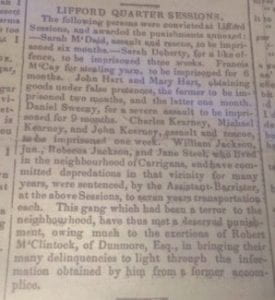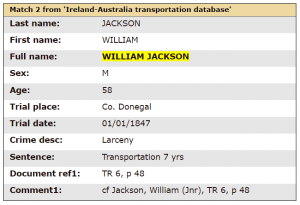According to Rebecca’s convict records, she was born in County Donegal about 1830. I have found a baptism record for her on 17 October 1830 No 486 at Taughboyne Parish Church, St Baithin’s Church of Ireland, Churchtown, Carrigans, County Donegal.
This record says her father was William and her mother Catherine Campbell. They were residing at Garshuey Parish of All Saints where William was a blacksmith.
Also baptised here with the same parents was John on 28 March 1827 No 321
Her convict indent also mentions siblings named John, James, William, Margaret, Mary and Catherine. Some of these were still in County Donegal while at least one of them was in America.
Her younger brother William was also convicted along with their father and another relative Jane or Sarah Steel.
Rebecca’s life as a child must have been tough. According to newspaper reports from the Donegal Quarter Sessions, Lifford, printed in the Londonderry Journal on 13 January 1847, the Jackson family were part of a gang.

Rebecca was mentioned in two cases heard by Mr McClintock at the Newtown Cunningham Petty Sessions
Anne Jackson of Garshuey(sic) and Anthony Gallagher of Ruskey a(gainst) William Jackson the Elder, William Jackson the Younger, Rebecca Jackson, Jane Steele and Mary Jane Gallagher
For that they did at Ruskey on the 1st day of April 1846 feloniously steal and carry away 4 stones of potatoes value 8d the property of Anthony Gallagher
Information taken returnable to Quarter Sessions at Lifford January 1847
The second case:
Anne Jackson, Caldwell Motherwell of Monglass, sub constable James Love?, Nelly Jackson of St Johnston and Joseph Wray of Curryfree(sic) County Derry a(gainst) William Jackson the Elder, William Jackson the Younger, Rebecca Jackson, Jane Steele and Mary Jane Gallagher
For that they did at Criche? on the 6th day of April 1847 into a certain dwelling House of one John Motherwell feloniously broke and enter and did then and there feloniously steal from one large cloak valued 2/5, one Mc Intosh(sic) cloak value 6d, 3 frock coats value 7/6, one body coat value 2/-, 3 pairs of trowsers(sic) value 6/-, 3 waistcoats value4/6, one sheet value 6d and one quilt value 6d the goods and chatels(sic) of Caldwell Motherwell, Motherwell
Information taken returnable to Quarter Sessions at Lifford January 1847
So with both the potato famine and a father who taught his children to steal, Rebecca probably had a better life once she arrived in Tasmania and completed her seven year sentence.
On 16 February 1847 at 7pm Rebecca, Jane and her two children Mary Jane Gallagher and John Gallagher were received into Grangegorman Female Prison in Dublin. Mary Jane was 13 years 6 months old while John was 8 years and 9 months. Rebecca was 16 and Jane 53.
Rebecca was described as 5 feet and half an inch, blue eyes, brown hair, fair complexion, single, neither read nor write, Presbyterian, a servant and never been convicted before.
On 14 July 1847, the records say she was disposed of from the prison and put on the ship Waverley. This ship departed Dublin on 17 July and arrived in Hobart Town, Van Diemens Land on 25 October 1847. Only 44 people both convicts and free settlers were on the sick list but not Rebecca, Jane or her children. There was a matron on board ship, Miss McCauslin, who was to look after the welfare of the women and children.
The surgeons report said Rebecca was of exemplary behaviour and could now read a little and was a nursemaid.
On arrival in Hobart Town, Rebecca and Jane were sent to the Anson Probation Station which was an old hulk moored at Prince of Wales Bay in the Derwent River. They spent 6 months in probation on here and then were able to be hired out for service. Jane’s two children were sent to the Queen’s Orphan School on 29 October. Mary Jane (Ann) remained there until 22 September 1849 when she was discharged to William Insley, Hobart. John remained until 8 April 1850 when his mother, who had since married and received her ticket of leave, took him out herself.
It is unknown if Rebecca and Jane kept in touch despite being relatives in a strange land.
Rebecca became a 3rd class passholder on 6 May 1848 which meant she could be hired and all wages would be paid directly to her. She was employed by Henry Hinsby, a chemist in Elizabeth Street, Hobart on 30 October 1849 for the princely wage of 8 shillings for a months work.
She received her Ticket of Leave on 2 July 1850.
On 27 November 1851, Rebecca Jackson and John England, a convict on the Pestonjee Bomangee applied for permission to marry. According to the record, this could not be complied with maybe because John had been transported for life in 1846 so had only completed 5 years of his conviction.1
How did the two meet? On 2 October 1849, John became a passholder gained from extra work while at Darlington on Maria Island. He then moved to Hobart and worked as a moulder with John Swaine in Collins Street, Hobart, then Crosby and Robinson in Campbell Street and again with John Swaine. 2 The population of Hobart was not that large that they couldn’t have met while Rebecca was at work.
16 October 1852 their first child William was born despite Rebecca and John not yet being married.3 The family were living in Molle Street in Hobart.
Rebecca received her certificate of freedom 3 January 1854 which was 7 years after her sentence began.
Once Rebecca was free, they applied again for permission to marry and it was approved on 20 September 1854. 4 Three weeks later on 16 October they married at St Georges Church when John was 23 and a moulder while Rebecca was 21. Witnesses were John Minty and Isabella Lovett. 5
26 December 1854 birth of son Henry Lewis. 6
22 February 1857 birth of Elizabeth 7
4 November 1859 birth of Edward (Jack) 8
30 November 1861 birth of Mary Ann 9
2 March 1864 birth of William James 10
28 July 1866 birth of a female child – name unknown still 11
3 December 1868 birth of George Thomas 12
In April 1868, Rebecca was in court as a witness to an assault that occurred near where she lived in Molle Street. 13
Was this Rebecca in June 1874 in trouble this time as a disturber and charged 5 shillings? 14
Did she have a dog at large in May 1885, so was fined 5 shillings and costs or seven days in gaol? 15
The family must have saved enough money to go into agreement to buy land but unfortunately Rebecca had to have a solicitor auction land and hereditaments in July 1887. 16
Rebecca’s husband died in 1905 and just the next year on 23 October so did Rebecca. The funeral was from her daughter’s house (Mrs J Bradley) to Kettering. 17
- https://stors.tas.gov.au/CON52-1-4P027J2K# ↩
- https://stors.tas.gov.au/CON33-1-84P56J2K# ↩
- https://stors.tas.gov.au/RGD33-1-4-P517J2K# ↩
- https://stors.tas.gov.au/CON52-1-7P035# ↩
- https://stors.tas.gov.au/RGD37-1-13P183# ↩
- https://stors.tas.gov.au/RGD33-1-5-P137J2K# ↩
- https://stors.tas.gov.au/RGD33-1-6-P432J2K# ↩
- https://stors.tas.gov.au/RGD33-1-7P257J2K# ↩
- https://stors.tas.gov.au/RGD33-1-8-P195J2K# ↩
- https://stors.tas.gov.au/RGD33-1-8-P421J2K# ↩
- https://stors.tas.gov.au/RGD33-1-9_202# ↩
- https://stors.tas.gov.au/RGD33-1-10-P081J2K# ↩
- http://nla.gov.au/nla.news-article232859693 ↩
- http://nla.gov.au/nla.news-article201166288 ↩
- http://nla.gov.au/nla.news-article9104382 ↩
- http://nla.gov.au/nla.news-article9136496 ↩
- http://nla.gov.au/nla.news-article12788451 ↩


